This is going to be a long post so get a drink or snack or something. I didn't aim to have a long post today, but lots of things happened and I want to share them with you guys.
First, I went to my therapist appointment this morning and I told myself to put my camera in my bag but I forgot. So naturally, when I pulled in there was a Spicebush ST flying on the plumbago. Luckily, it was nice enough to stick around for a few pictures. You can kind of see it's missing part of a wing.

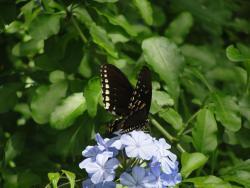
I finally found the culprit who is laying eggs on my pipevine. It's a Polydamas ST (but I knew that). Just hadn't seen her in action until now. I tried to get a picture with the wings open but this is the best I could do because they literally never stop fluttering their wings.
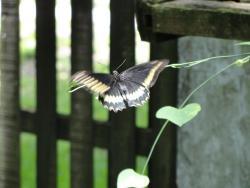
She calmed down to lay some eggs but still kept her wings fluttering just a bit which is why they're a little blurry. I found three clutches of eggs. You can see two eggs in the picture.
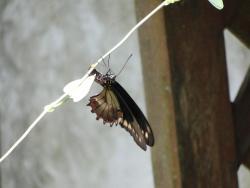
Here's the cluster once she was done.
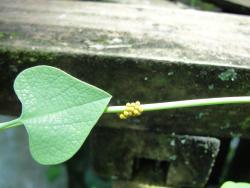
I walked around to the other side of the fence to check for more eggs but found more caterpillars! They're all living in a small tupperware dish right now with the eggs. I didn't want them getting lost in the big tank with the big caterpillars.
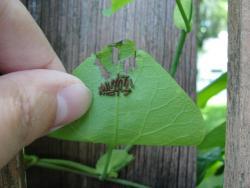
The Zebra Longwings are still out there and still on the firebush.
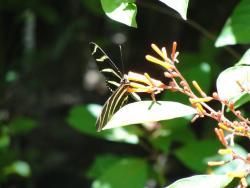
Saw this extremely fast skipper on the Spanish Needles. BAMONA confirmed that last skipper I saw as a Whirlabout and this guy looks pretty similar, but lots of skippers look similar.
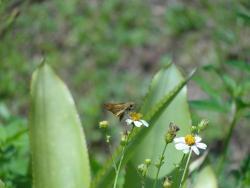
And my faithful Duskywings are also on the Spanish Needles.
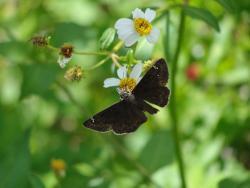
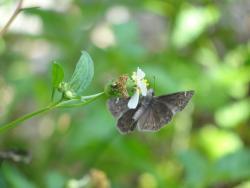
There were also the usual Gulf Frits and I even saw a Tiger ST fly through the yard but couldn't get pictures of either. Ok, now we're going to switch to the caterpillar part of today's lesson. I was talking about how when a caterpillar molts their new head capsule and true legs are paler in color than usual. Here you can see it on a Polydamas that just molted. And yes, they always cluster like that for some reason. This morning I had one hanging by his butt and I had to gently place him back on a small piece of pipevine so he could molt. But why they do it with all those other caterpillars in the way? I have no idea.

And here is a better side view of his just-molted body with the skin behind him.
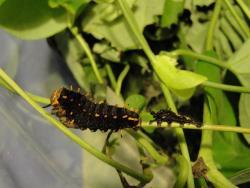
And here's another photo showing the difference between the Pipevine STs and the Polydamas STs. Pipevines have much longer front tubercles. Mom didn't know the difference until I pointed it out. I had the Pipevines out first and she thought they were Polydamas. So I brought them out and showed her the difference. The Pipevine ST is on the left side of my hand.
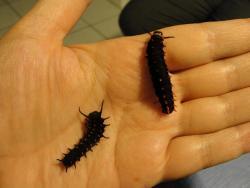
Sometimes, caterpillars will damage a tubercle and one will be shorter than the other. I see this on Monarchs occasionally but here you can see it on a Pipevine ST. Generally, once it's damaged, it won't grow back even when they molt. It will stay short.


I didn't want to talk about it, but my Long-Tailed Skippers died. They have lousy survival rates in the first place but I also think they require fresh food and a lot of their host plants dry out pretty quick once picked. I was feeding them butterfly pea, but it dried out fast so it's probably part my fault. In the wild, they eat Desmodium spp. which most people around here know as "those seeds that stick to your socks". It doesn't dry out as fast but I don't have much growing anymore since someone has been mowing the area where it used to be. My neighbor had some but a group of workers showed up the other day and totally sheared his yard. I feel bad for the White Checkered Skippers that were laying their eggs out there. Anyway, I was checking the False Indigo (Amorpha fruticosa) today and saw clear caterpillar activity. Take a look at this picture. Start at the right and you can see a leaf with a little home and progressively larger homes as you move left until the leaf all the way to the left is simply folded over. That's where the caterpillar was.
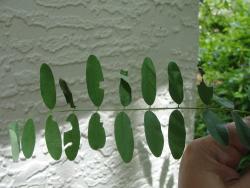
Now, any caterpillar book will tell you that False Indigo is a host plant for the Southern Dogface and the Silver-Spotted Skipper. I've gotten the Silver-Spotted Skippers a couple of times, but these aren't them. These are Long-Tailed Skippers. They do use things in the bean/pea family so this isn't unheard of but I've grown this plant for at least five years and this is the first time they've ever used it. We also get the similar Dorantes Skipper but I can tell this is a Long-Tailed because of that orange area on his rear end. They're the only ones that have that. The liquid you see on the leaf is where he threw up on me because he was mad I opened up his shelter and he was defending himself.
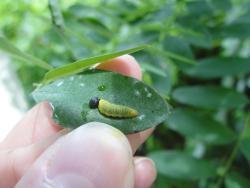
Here's another leaf shelter I found. There's actually two here, the smaller one on the right and the bigger one on the left that is actually two leaves silked together.
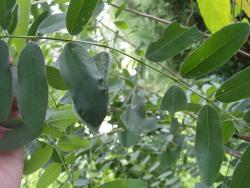
And sometimes, a caterpillar just needs three leaves to feel at home.
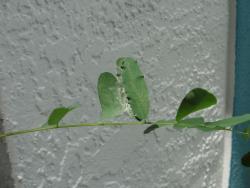
Back inside, I inspected the three caterpillars I found. This Long-Tailed Skipper is normal but the other two were molting. You see they can stick out their necks a little. You can also see again how his booty is orange.

Now, this guy is about to molt and you can see his neck and head look very different. This is why it's important to know what your caterpillar looks like normally, so you know when he's either not being normal, or molting.
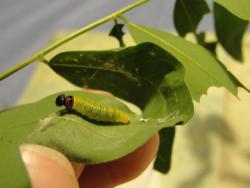
And if you ever wondered what an empty egg looks like, here you go. This is a Long-Tailed Skipper egg.
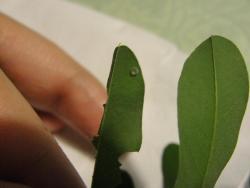
That's the last of the pictures, but I wanted to add that my Spicebush experiment showed that the caterpillar preferred spicebush to camphor. He didn't eat any camphor but ate quite a bit of spicebush. I've got some sassafras in there right now. He still doesn't seem to be growing, though.





















